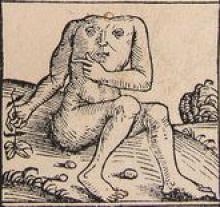Historically, the Blemmyes were first described by Pliny the Elder. (That right there should put you on your guard, because old Pliny tended to play fast and loose with what we think of as "facts.") Pliny the Elder described them as having no heads, with "their mouth and eyes are put in their chests."
Sketches of the time show exactly that: people without heads, with their facial features embedded in their chests. While it is theoretically true that a human being's mouth and nose could be hooked up through their chest (imagine the esophagus and trachea being detoured to the front of the chest) one can't help but point out that there is no room for a brain.
The human brain is a fairly large object, about the size of a football, and weighing about three pounds. Needless to say, it would be difficult to fit a brain inside a chest cavity.
Pliny the Elder was well aware of the importance of the brain to functioning. Even the most primitive cultures knew that the brain was pretty necessary. And yet he chose to write down this information about the Blemmyes without a second thought. Which should give any observer pause for thought.
One explanation for the Blemmyes is that they were normal humans who had somehow managed to raise their shoulders to surprising heights. When you see the kind of anatomical alterations which are possible through methods like cradle boarding, foot binding, and neck stretching, this starts to seem somewhat credible.
Another explanation was put forth by science fiction author Bruce Sterling, who wrote a short story called "The Blemmyes' Strategem" in which the eponymous Blemmye is "an alien living on Earth at the time of the Crusades."
Adding to the strangeness, Blemmyes were identified several times as being cannibals. These headless, man-eating tribesmen were said to live in North Africa and the Middle East.
Now the really confusing part: there was an actual civilization called the Blemmyes, who were based in what is now Sudan. This was a semi-nomadic herding culture, which several times clashed with the Roman Empire. Needless to say, the real life Blemmyes had normal heads like normal people, and were not known to be cannibals.
Most researchers believe that the Blemmyes exist today as the Beja people. The Beja occupy the same territory, and are comprised of several different tribes, most of which are nomadic or semi-nomadic herdspeople. Many of the Beja people take great pride in their hair, which they grow out to surprising volume, similar to the mane of the lion, who is worshiped like a god.
Could these dramatic hairstyles be what Pliny the Elder was trying to describe, when he went off on that odd "headless" tangent? Or could it be that the traditional desert dress, the head garb worn by the Bedouin and other nomadic desert tribes, might have given some early explorers the mistaken impression that they had their faces in the middle of their chests? It's as good an explanation as any. (If less intriguing than Sterling's hypothesis that the Blemmyes were aliens.)
Sketches of the time show exactly that: people without heads, with their facial features embedded in their chests. While it is theoretically true that a human being's mouth and nose could be hooked up through their chest (imagine the esophagus and trachea being detoured to the front of the chest) one can't help but point out that there is no room for a brain.
The human brain is a fairly large object, about the size of a football, and weighing about three pounds. Needless to say, it would be difficult to fit a brain inside a chest cavity.
Pliny the Elder was well aware of the importance of the brain to functioning. Even the most primitive cultures knew that the brain was pretty necessary. And yet he chose to write down this information about the Blemmyes without a second thought. Which should give any observer pause for thought.
One explanation for the Blemmyes is that they were normal humans who had somehow managed to raise their shoulders to surprising heights. When you see the kind of anatomical alterations which are possible through methods like cradle boarding, foot binding, and neck stretching, this starts to seem somewhat credible.
Another explanation was put forth by science fiction author Bruce Sterling, who wrote a short story called "The Blemmyes' Strategem" in which the eponymous Blemmye is "an alien living on Earth at the time of the Crusades."
Adding to the strangeness, Blemmyes were identified several times as being cannibals. These headless, man-eating tribesmen were said to live in North Africa and the Middle East.
Now the really confusing part: there was an actual civilization called the Blemmyes, who were based in what is now Sudan. This was a semi-nomadic herding culture, which several times clashed with the Roman Empire. Needless to say, the real life Blemmyes had normal heads like normal people, and were not known to be cannibals.
Most researchers believe that the Blemmyes exist today as the Beja people. The Beja occupy the same territory, and are comprised of several different tribes, most of which are nomadic or semi-nomadic herdspeople. Many of the Beja people take great pride in their hair, which they grow out to surprising volume, similar to the mane of the lion, who is worshiped like a god.
Could these dramatic hairstyles be what Pliny the Elder was trying to describe, when he went off on that odd "headless" tangent? Or could it be that the traditional desert dress, the head garb worn by the Bedouin and other nomadic desert tribes, might have given some early explorers the mistaken impression that they had their faces in the middle of their chests? It's as good an explanation as any. (If less intriguing than Sterling's hypothesis that the Blemmyes were aliens.)
